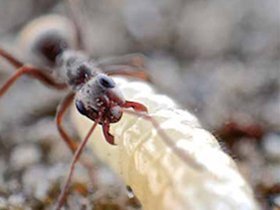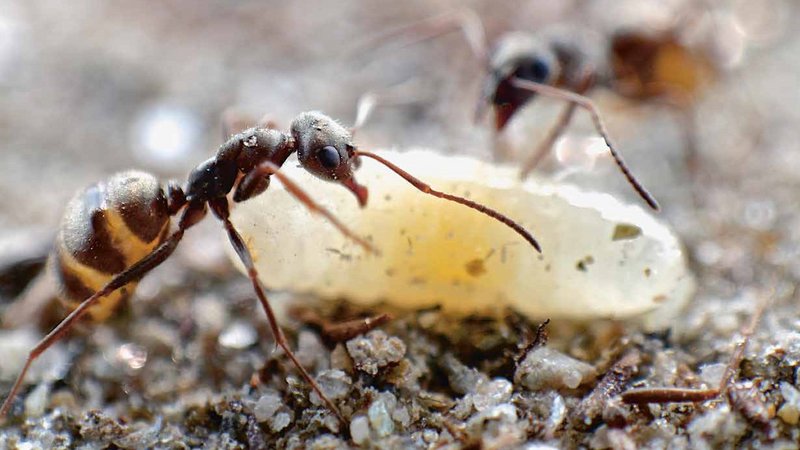
Fig. 1. Worker ant of Formica selysi with a larva. Photo: Timothée Brütsch
Ants don’t let their dead sisters rot away in their colony. They carry them out to ‘graveyards’. There, after a certain time, the carcasses are often home to a proliferation of fungus spore carriers, a fungus that had already infected them during their lifetime. This fungus grows inside the dead ant’s body and draws out the water. It thereby mummifies the corpse – and out of it, ultimately, the next generation of deadly spores sprouts like a thick white fur coat.
Wood ant colonies in Valais

Fig. 2. The structure of a nest of Formica selysi in the ground. Photo: Michel Chapuisat
For fifteen years now, Michel Chapuisat’s team of biologists at the University of Lausanne has been observing an extended population of ants belonging to the species Formica selysi in the canton of Valais. Chapuisat has taken spores of Beauveria bassiana from one of the ant graveyards for his experiments.
This killer fungus, named after the Italian scholar Agostino Bassi, also attacks a multitude of other insects. Bassi proved 180 years ago that the ailment affecting caterpillars in the silkworm cultures that were then widespread in France and Italy had been triggered by a biological pathogen (and he thereby proved the validity of the germ theory of disease before Louis Pasteur and Robert Koch). Today, this fungus is also used as an instrument of biological pest control, for example against scale insects.
"Ant colonies are really an ideal breeding ground for pathogens" says Chapuisat. It’s always warm and humid in the colonies, and the hustle and bustle means there’s no lack of opportunities for infection. Furthermore, in nests with only one queen, the worker ants are genetically closely related to each other.
It’s thus extraordinary that such ant colonies aren’t simply wiped out – as sometimes happens with monocultures in cornfields, for example. The resistance of the ants, says Chapuisat, is a result of the species having had enough time – some 100 million years – to develop their astonishing arts of defence against pathogens.
Strong against pathogens together
What especially interests him are the collective or social defence mechanisms that depend on the cooperation of different individuals. The fact that there are ant ‘graveyards’ shows that ants are social beings. “Ants are pretty civilised”, says Chapuisat. The existence of graveyards, for example, presupposes that workers place the protection of the colony above their own well-being. Their contact with the dead means they risk becoming infected with the germs, but by carrying the carcasses out it means that the fungus spores can only mature outside the ant colony.
Fighting bacteria with conifer resin
Furthermore, ants possess a so-called ‘social immunity’. They don’t just clean themselves, but they help to clean their co-inhabitants and their sisters and to keep them as free from germs as possible. Their collective defence is actually supported by the architecture of the colony. A few years ago, Chapuisat noticed that the workers of several ant species were carrying small pieces of hardened conifer resin into the colony. Large anthills can contain up to 20 kilos of this scented material, which is exuded by conifer trees in order to close up their wounds. The substances contained in it inhibit the growth of bacteria and fungi – and this doesn’t just work on conifer trees, but also in ant colonies. With this type of collective medication, the insects manage to protect their brood better from germs, as Chapuisat and his team have been able to prove.
Influence of the social environment
For his new study, Chapuisat went to collect ants once more in the Valais, along with his colleague Jessica Purcell. They visited 50 anthills and took 50 eggs and worker ants from each of them. In the laboratory they put the workers of colony A in charge of the eggs of colony B and vice versa. The carer ants had a lot to do. Larvae hatched from the eggs and pupated, then the new workers emerged. Purcell and Chapuisat dripped fungus spores gathered from the graveyards onto the backs of some of these ants. They also exposed the carer ants to the germs. And it turned out that the more resistant the carer ants were, the more resistant were the new workers too. This similarity of immunity cannot be genetically determined, because the experiment used eggs and carer ants from different nests that were unrelated to each other. "So the social environment influenced the resistance of the ants during their development”, says Chapuisat. Differences in immunity might be traced back to some special behaviour on the part of the carer ants, or to different molecules on the surface of the ants that “determine the scent of an ant nest” and help the ants to recognise their own colony.

Fig. 3: Two worker ants of Formica selysi looking after a larva. Photo: Timothée Brütsch
Control of resistance to disease via the ‘social stomach’?
Or do differences in their resistance to disease originate in differences in the ‘social stomach’ of the different ant colonies? Many workers vomit up part of their diet and give it to the larvae or other members of the colony, so they also share their microbes with each other. This could play an important role in defending them against pathogens. "There are lots of ideas about this, but at the moment there isn’t much solid data that would support any one explanation”, says Chapuisat.
His investigations into collective defence mechanisms of ants don’t allow us to deduce any strategies to help humans avoid dangerous epidemics. “Our research is not intended to improve protection against dangerous pathogens among people”, says Chapuisat. Together with his team, he’s engaged in basic research, and their interest is in the mechanisms of evolution that promote collaboration between individuals. Fundamentally, these mechanisms also function among us humans – even if that’s only been the case for a few million years for us, and thus a fraction of the time during which social insects have been working together.


